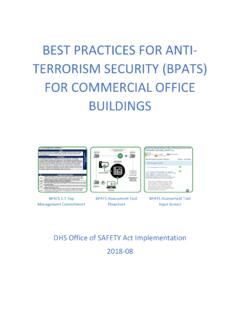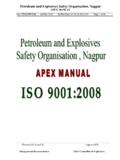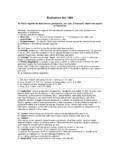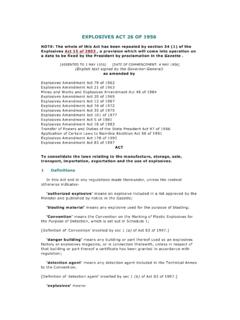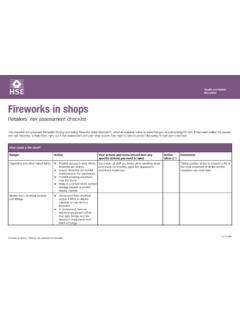Transcription of The Support Anti-terrorism by Fostering ... - SAFETY Act
1 SAFETY Act 101 Briefing The Support Anti-terrorism by Fostering effective technologies ( SAFETY ) Act of 2002 Office of SAFETY Act Implementation Science and Technology Directorate Presenter s Name June 17, 2003 Congressionally enacted as part of the Homeland Security Act of 2002 Provides legal liability protections for *Sellers of qualified Anti-terrorism technologies (QATTs) that could save lives in the event of a terrorist attack Protections apply only to claims arising out of, relating to, or resulting from an Act of terrorism when SAFETY Act approved technologies have been deployed *Seller- any person, firm, or other entity that provides a QATT to customer(s) and to whom SAFETY Act protection has been issued A Summary of the SAFETY Act 2 Presenter s Name June 17, 2003 What is Eligible for SAFETY Act Protections?
2 3 Examples of eligible technologies : Threat and Vulnerability Assessment Services Detection Systems Blast Mitigation Materials Screening Services Sensors and Sensor Integration Threatening Object Detectors Decision Support Software Security Plans / Services Crisis Management Systems Venue Security The SAFETY Act liability protections apply to a wide range of technologies , including: Products Services Software and other forms of intellectual property Presenter s Name June 17, 2003 Multi-layered security system deployed at a major venue Anti-terrorism detection, collection, and analysis tool for the detection of terrorist surveillance and pre-attack planning System design, integration, monitoring and maintenance for perimeter security and anti-intrusion systems Physical security services that deter, prevent, detect, alert and respond to a variety of security threats at commercial facilities Recent Approvals 4 Presenter s Name June 17, 2003 Explosives detection canine services Real-time, web-based situational awareness dashboard.
3 Data surveillance and early-warning software system An evacuation planning tool undergoing testing and evaluation that provides evacuation modeling for sports stadiums Codes and standards that have an association with preventing, detecting, identifying, deterring acts of terrorism or limiting the damage such acts might cause Recent Approvals 5 Presenter s Name June 17, 2003 1. Two Principal Levels of Protection Developmental Test & Evaluation (DT&E) Designations: Additional evidence of effectiveness needed. Shows potential Full Designation: Proven effectiveness Certification: High confidence it will continue to be effective Government Contractor Defense Liability Cap Essential Concepts 6 Presenter s Name June 17, 2003 2. Benefits of Designation Liability = Insurance determined by the DHS Exclusive action in Federal Court No Joint and Several Liability for non-economic damages No punitive damages or prejudgment interest Recovery reduced by amounts from collateral sources Essential Concepts 7 Presenter s Name June 17, 2003 In determining the amount of liability insurance required, the DHS may consider.
4 The particular Technology at issue The amount of liability insurance the Seller maintained prior to application The amount of liability insurance maintained by the Seller for other technologies or for the Seller s business as a whole The amount of liability insurance typically maintained by Sellers of comparable technologies Information regarding the amount of liability insurance offered on the world market Data and history regarding mass casualty losses The intended use of the Technology The possible effects of the cost of insurance on the price of the product, and the possible consequences thereof for development, production, or deployment of the Technology. Liability Insurance Required 8 Presenter s Name June 17, 2003 The Seller shall provide.
5 Names of insurance companies, policy numbers, and expiration dates A description of the types and nature of such insurance (including the extent to which the Seller is self-insured or intends to self-insure) Dollar limits per occurrence and annually of such insurance, including any applicable sub-limits Deductibles or self-insured retentions, if any, that are applicable Any relevant exclusions from coverage under such policies or other factors that would affect the amount of insurance proceeds that would be available to satisfy third party claims arising out of, relating to, or resulting from an Act of terrorism Liability Insurance Required 9 Presenter s Name June 17, 2003 The price for such insurance, if available, and the per-unit amount or percentage of such price directly related to liability coverage for the Seller s QATT deployed in defense against, or response to, or recovery from an Act of terrorism .
6 Where applicable, whether the liability insurance, in addition to the Seller, protects contractors, subcontractors, suppliers, vendors and customers of the Seller and contractors, subcontractors, suppliers, vendors and customers of the customer to the extent of their potential liability for involvement in the manufacture, qualification, sale, use or operation of QATT deployed in defense against, response to, or recovery from an Act of terrorism . Any limitations on such liability insurance. Liability Insurance Required (cont.) 10 Presenter s Name June 17, 2003 Has to maintain the required insurance. The Under Secretary may terminate a Designation if the Seller: Fails to provide any of the insurance certifications required Provides a false certification Seller s Continuing Obligations 11 Presenter s Name June 17, 2003 3.
7 Benefits of Certification Benefits of Designation + Assert Government Contractor Defense that immunizes Sellers of qualified Anti-terrorism technologies from liability for claims brought under the SAFETY Act Placed on SAFETY Act s Approved Product List for Homeland Security Essential Concepts 12 Presenter s Name June 17, 2003 4. SAFETY Act Protections Extend to Users (whether Designation or Certification) Such cause of action may be brought only against the Seller* of the QATT** and may not be brought against the buyers, the buyers contractors, downstream users of the Qualified Anti-terrorism Technology, the Seller s suppliers or contractors, or any other person or Preamble to Final Rule, 6 CFR Part 25, at 33150 Essential Concepts 13 Presenter s Name June 17, 2003 5.
8 Criteria for Designation Prior United States Government use or demonstrated substantial utility and effectiveness Availability of the Technology for immediate deployment in public and private settings Existence of extraordinarily large or unquantifiable potential third party liability risk exposure to the Seller or other provider of the technology Substantial likelihood that the Technology will not be deployed unless SAFETY Act risk management protections are extended Magnitude of risk exposure to the public if the Technology is not deployed Evaluation of scientific studies that can be feasibly conducted in order to assess the capability of the Technology to substantially reduce risks of harm Whether the Technology is effective in facilitating the defense against Acts of terrorism ATT determination made by Federal, State, or Local officials Essential Concepts 14 Red=Technical criterion Blue=Economic criterion Presenter s Name June 17, 2003 5a.
9 How to Establish Effectiveness Successful testing in operational environment Operational testing Evidence of performance metrics, including: Probability of Detection False Positive and False Negative Rates Limits of Detection (and why that limit is relevant) Interferrents Maintenance and Training Suitable performance of past deployments documented Domain expertise appropriate and available In/external audits favorable Customer feedback favorable QA plans documented Repeatability proven Essential Concepts 15 Presenter s Name June 17, 2003 6. Criteria for Certification Designation is a prerequisite for granting Certification. To receive Certification, a QATT must also be shown to: Perform as intended Conform to the Seller s specifications Be safe for use as intended Seller is required to provide SAFETY and hazard analyses Essential Concepts 16 Presenter s Name June 17, 2003 6a.
10 Performs as Intended High confidence it will continue to be effective : Consistent positive results ( , long-term low failure rates and false alarms) Reliability/Availability is high ( , MTBF) Performs in accordance with performance specifications Installation, use, maintenance procedures proven Documented processes ( , training, hiring, technology refresh) are being followed Standards are identified and met QA/QC processes are effective Essential Concepts 17 Presenter s Name June 17, 2003 7. DT&E Designation For technology that: Is in a prototype stage Has lab tests that are not operational in nature (too controlled) Indicated potential effectiveness Has a testing scenario identified and customers to prove relevant metrics Limited term (up to 3 years) and limited number of sites Essential Concepts 18 Presenter s Name June 17, 2003 8.
